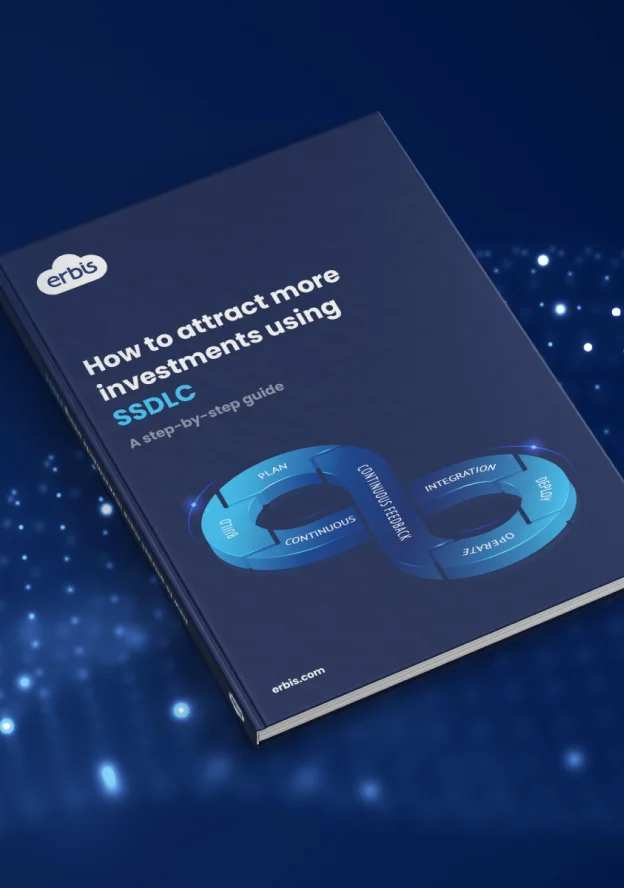As the SaaS market grows year by year, more players emerge in this sphere. However, along with this growth, there are more pitfalls observed among those attempting to enter the market.
At Erbis, we have traversed the path of SaaS development many times, so we are familiar with all the pitfalls you might encounter.
In the following, we want to share our own experiences and advice on what to pay attention to from both a business and technological standpoint.
The post will be focused on the key milestones of SaaS application development, modern technologies used in SaaS development, pricing strategies, and trends to watch out for in 2024.
We put our 11 years of expertise into this publication and share practical recommendations for founders, project managers, developers, and other stakeholders.
SaaS essentials
SaaS concept
SaaS benefits
SaaS pricing models
SaaS concept
SaaS, or Software as a Service, is a cloud computing model that delivers software over the internet. Instead of users downloading and installing software, SaaS allows access to applications through a web browser.
SaaS has become increasingly popular for various applications. They range from productivity tools and customer relationship management (CRM) to collaboration platforms.
On average, organizations are now using 110 SaaS apps, which is a seven-fold increase since 2017.
Companies choose SaaS primarily for its accessibility, collaboration opportunities, and flexible pricing. It's also convenient because SaaS allows organizations of any size and development stage to use advanced features in their daily operations.
SaaS benefits
SaaS benefits will be considered from the perspective of a SaaS product development company or SaaS owner. If you are or want to become such a business, here's what you can count on:
Recurring revenue model. Software as a Service (SaaS) products are designed to operate on a subscription-based model, which means that customers pay a recurring fee to access the software. This model provides several benefits, including financial predictability and stability for the company.
By having a steady stream of recurring revenue, SaaS companies can better forecast their cash flow and plan for future growth. It also allows them to focus on providing high-quality customer support and continuously improving their software, as they don't have to worry about generating revenue through one-time sales.
Global reach. Software as a Service (SaaS) products have revolutionized the way companies do business by providing them with a global reach. With SaaS products, companies can now offer their services and products to a worldwide audience without the need for physical distribution. This has opened up new markets and customer segments that were previously inaccessible.
By leveraging the power of the internet, companies can now expand their reach and tap into new revenue streams. This has also made it easier for companies to scale their operations and grow their business without the need for significant investments in infrastructure and logistics. SaaS products have truly transformed the way companies do business in the digital age.
Scalability. SaaS applications are designed to be highly scalable, which means they can easily handle an increase in user demand without any significant impact on performance. This is achieved by using cloud-based infrastructure that can simply be expanded as needed.
As the user base grows, the SaaS provider can add more servers, storage, and other resources to ensure that the application continues to run smoothly. This scalability is a key advantage of SaaS applications, as it allows businesses to easily accommodate growth without worrying about the complexities of managing their own infrastructure.
Rapid deployment and updates. SaaS vendors push updates to all users at once, ensuring that everyone has access to the latest software version. Moreover, SaaS vendors typically follow a continuous delivery model, which means they release updates in small increments rather than one big update.
This approach allows faster testing, feedback, and iteration. It enables vendors to address bugs quickly and improve the software in a short time. Overall, SaaS is a highly efficient software delivery model that ensures prompt access to the latest improvements and eliminates the need to support older software versions.
Customer retention. The subscription-based model encourages long-term relationships with clients. Regular updates keep customers engaged and give them a reason to continue their subscriptions. Helpful support resolves any issues that might have arisen and ensures that customers are satisfied with SaaS usage. Software features evolve to adapt to changing customer needs and keep them continuously engaged.
The subscription-based SaaS model is a powerful way to build long-term relationships with customers. By quickly responding to user needs, SaaS vendors retain and grow their customer base.
Competitive edge. SaaS companies have a competitive edge in the market due to their ability to quickly respond to customer demands. With the software being hosted in the cloud, SaaS companies can introduce new features or adapt to industry trends promptly without the need for customers to download or install any updates.
Such flexibility allows SaaS providers to stay ahead of their competitors by offering the most innovative solutions to customers. Additionally, SaaS companies can collect data on customer usage and behavior and use it to provide a more personalized experience to customers.
SaaS pricing models
Navigating SaaS product pricing involves achieving a balance between achieving a rewarding return on investment for your business, and providing the value for money that subscribers seek to justify their outlay.
While it might seem straightforward, especially for SaaS startups, finding the right equilibrium between costs and revenue is complex. Set the price too low, and you risk failing to cover expenses. Set it too high, and you may drive away potential subscribers.
This challenge becomes particularly daunting for new managers, often better versed in technical operations than in the tricks of business management. To navigate this landscape successfully, we'll explore various SaaS billing models. It's essential to delve deep into each option to find the best fit for your service.
Flat-rate pricing
Customers pay a fixed fee for the entire SaaS service, regardless of usage.
Example: Basecamp. It offers a fixed monthly fee of $99, providing 500GB of storage, unrestricted projects, unlimited users, and no extra charges per user.
Pros: Simplicity and predictability for customers.
Cons: May not align with actual usage, potentially leading to undercharging or overcharging.
Usage-based (pay-as-you-go) pricing
Charges are based on actual usage or consumption of the SaaS service, such as the number of transactions, storage space, or data transfer.
Example: Google Cloud Platform. This service bills customers based on the computing resources they consume.
Pros: Offers flexibility for customers and cost scales with usage.
Cons: Costs can be unpredictable, and customers may hesitate if usage is difficult to estimate.
Tiered pricing
SaaS services are offered in packages or tiers with different features or usage limits. Customers select the tier that best suits their needs.
Example: HubSpot provides tiered pricing for its Marketing Hub, Sales Hub, and Service Hub, allowing users to choose plans based on their needs and business size.
Pros: Provides options for various customer segments and incentivizes upselling.
Cons: Some customers may find it challenging to choose the right tier for their needs.
Per-user pricing
SaaS pricing is based on the number of users accessing the service. Common in collaboration and productivity tools.
Example: Zoom charges on a per-host basis, meaning companies pay for each user who hosts a meeting.
Pros: Scales with the size of the user base, predictable costs for growing organizations.
Cons: May not align with the actual usage intensity of each user.
Freemium model
Basic SaaS features are offered for free, and users can upgrade to a paid version for premium features or expanded usage.
Example: Slack provides a free version with limited features and offers more advanced capabilities in paid plans.
Pros: Attracts a large user base, encourages users to upgrade.
Cons: Monetization relies on a small percentage of users upgrading, and balancing free and premium features is crucial.
License-based pricing
Customers purchase a SaaS license for a specific period, often annually. Common in enterprise software.
Example: Microsoft Office 365 offers licenses based on the number of users.
Pros: Predictable revenue, long-term commitments.
Cons: May require a significant upfront investment, and customers might be locked into contracts.
Custom pricing
Tailored SaaS pricing based on individual negotiations with enterprise clients. Often used for large, complex implementations.
Example: SAP provides various enterprise software solutions, including ERP, CRM, and data management systems. Their pricing is often customized based on the specific needs of enterprise clients.
Pros: Adaptable to the unique needs of each customer.
Cons: Requires more extensive sales efforts and negotiation.
Penetration pricing
A company sets a low initial price for SaaS services to gain a large market share quickly. Once it attracts a significant number of customers, it raises the price.
Example: Netflix. The company initially set a low price per DVD rental, which allowed it to force out its main competitor, Blockbuster. In 2007, when Netflix launched its streaming service, it already had a large base of loyal customers.
Pros: Rapid market entry and gaining a significant market share early.
Cons: Lower prices may impact short-term profitability and create a perception of lower quality.
Prestige pricing
A SaaS offering is priced higher to convey a sense of exclusivity or premium value. This pricing model often caters to a specific segment willing to pay more for perceived superiority.
Example: Salesforce Unlimited. This edition is positioned at a higher price point and includes advanced features, enhanced support, and customization options.
Pros: High profit margins, enhanced brand image, and high-value customers.
Cons: The risk of failing to meet high expectations can damage the brand's reputation.
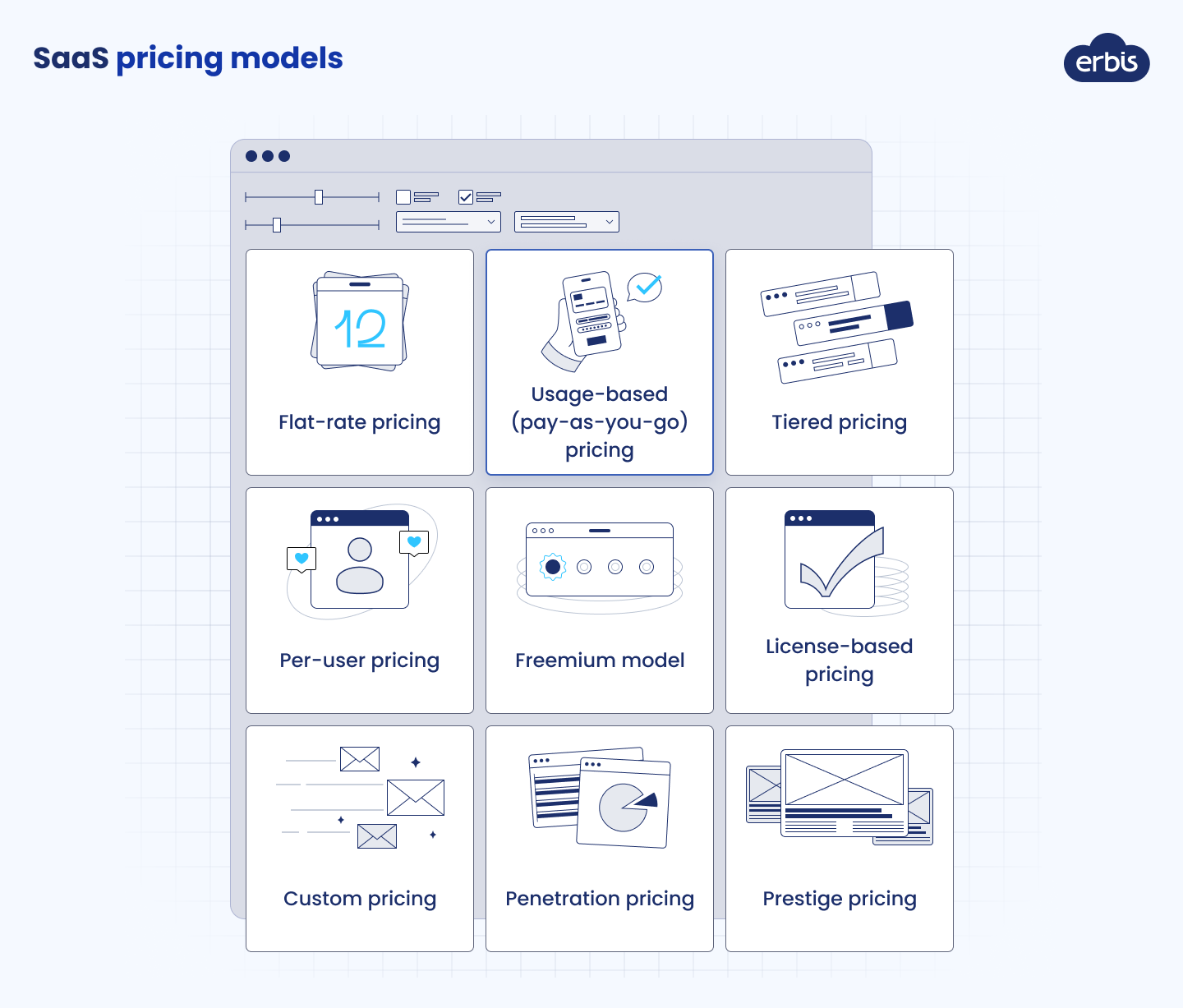
Choosing your SaaS development niche
It is a well-known fact that 90% of startups fail. The main reasons for that are poor product-market fit, incorrect marketing strategies, and human-resource-related issues.
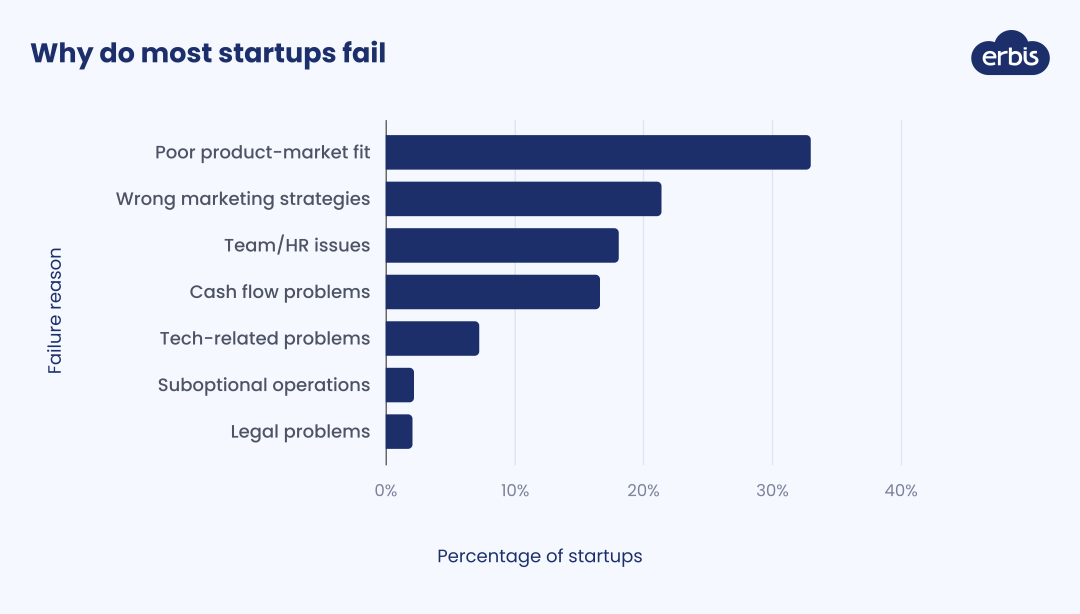
Before starting the development process, it's important to conduct thorough research on your target market and select the right product niche.
Below are the most popular niches for SaaS development in 2024.
LegalTech SaaS
Reasons to enter the legal SaaS development market
1. Corporate legal teams are overburdened with workload and seek ways to optimize operations with technology.
79% of lawyers say coping with increased volume and complexity of information is a top trend with impact.
Wolters Kluwer
2. Legal departments aim to collaborate with high-tech law firms because they see them as more productive and customer-oriented.
91% of corporate legal departments believe that having a law firm that fully leverages technology will be crucial in the next three years.
Wolters Kluwer
3. Law firms face growing corporate risks and need technology to help manage them.
68% of the top 100 law firms in the UK feel concerned about cyber threats. 18% of these firms feel extremely concerned about this.
PwC
4. Legal sector employees who already use technology note an increased KPI.
32% of users report a decrease in task completion time, 21% note a decrease in task difficulty, and 21% report spending less time on non-billable tasks.
Bloomberg
5. Legal leaders see tangible benefits from adopting SaaS technologies and plan to grow investments in tech.
63% of legal leaders are investing more in legal tech due to high inflation rates.
Gartner
Target audiences in LegalTech
Law firms. Law firms often grapple with time-consuming administrative tasks, including document management, legal research, billing, scheduling, etc.
LegalTech SaaS can streamline these tasks, allowing legal professionals to focus more on substantive legal work.
Corporate legal departments. In-house legal teams within corporations deal with contract management, compliance monitoring, and legal analytics on a daily basis. SaaS custom software aims to improve the operational efficiency of legal departments within businesses.
Legal compliance and regulatory professionals. These professionals ensure that organizations comply with laws, regulations, and industry standards relevant to their operations. LegalTech SaaS can help them automate compliance monitoring and manage regulatory changes more efficiently.
LegalTech SaaS solutions you can create
CRM and document automation. Lawyers can effortlessly upload documents into the system to ensure their professional appearance. They can also streamline the document management process. All in all, such SaaS platforms aim to deliver visually appealing documents and provide easy navigation through them.
Dynamic document constructor. Legal professionals can efficiently gather client information, click through a user-friendly interface to populate documents, and voila – the document is ready, delivering simplicity and speed.
Case management (legal ERP). Employees of law firms and legal departments can access current cases and related activities. They open the system, select the case, and gain a comprehensive view of everything related to their project. This allows for more efficient project management and faster results.
Knowledge hub for legal professionals. A Wikipedia-like knowledge hub for legal professionals securely stores information from past cases. It allows quick access to past cases, relevant documentation, and involved persons.
Contract risk analysis software. This assists legal professionals in evaluating risks associated with contractual agreements. AI-based algorithms analyze contract language, terms, and conditions, helping organizations identify potential risks and mitigate them effectively.
Trademark and patent research system. These SaaS solutions leverage various databases, search algorithms, and analytics to help users investigate the availability, registrability, and legal status of trademarks and patents.

EdTech SaaS
Reasons to enter the educational SaaS development market
1. Users willingly pay for EdTech technologies as they see valuable results from using it
80% of sales in the education industry come from the EdTech market
Future Market Insights
2. EdTech is developing at a tremendous pace, conquering various target markets and segments
900% is the actual growth figure that the EdTech market has reached, starting from the year 2000
Oxford College
3. Online education has proven to be highly efficient
70% of students think that online classes are a better alternative to the traditional classroom setting
University of the Potomac
4. Educational establishments are increasingly integrating technologies into the educational process
64% of schools in the UK incorporate technology as a part of their daily teaching and learning activities
Smarttech.com
5. The use of information and communication technology (ICT) in classrooms is low, even in the wealthiest countries
40% is the highest level of technology usage in science classrooms, observed in Denmark. This is followed by Australia at 30%, the United States at 15%, and Japan at 7%.
Unesco
Target audiences in EdTech
Private schools. Of course, you can also target public schools, but winning over these customers will be more challenging. The thing is, public schools are constrained by stringent government budgets or funding limitations, whereas private schools are more flexible in their budgets and decision-making.
Teachers and instructors. Educators often seek tools to facilitate online teaching, automate administrative tasks, and enhance student engagement. These don't necessarily have to be official school tools; instead, these can be handpicked programs that assist at various stages of learning.
Organizations. Organizations conducting corporate training and workshops are interested in EdTech SaaS. With the help of technology, these organizations can conduct training sessions for employees in different locations and customize the individual pace of learning.
Adult learners. These users can be people from different backgrounds who want to acquire new professional skills, enhance existing ones, or simply learn something new for themselves.
Younger learners. This audience can range from infants to teenagers. You should develop SaaS with age-specific considerations in mind. For example, for the little ones, use as much visual content as possible; for older ones, include more complex storylines or challenging rewards.
EdTech SaaS solutions you can create
Parental portals. These SaaS applications provide parents with convenient access to information about their children's education and school activities. This is typically a bespoke SaaS application developed for a specific school.
Assessment tools. These facilitate the creation and evaluation of school assessments and exams. During an assessment SaaS development, you may include features like automated grading of objective questions, randomization of questions and answer options, AI-based assessment, etc.
Learning management systems (LMS). This helps organize, track, and deliver educational content in various formats. LMS may interest businesses holding internal training, online course providers, and educational establishments.
Adaptive learning platforms. These SaaS provide personalized learning experiences by adjusting the content, pace, and approach to individual learners. They use data, algorithms, and AI to dynamically tailor instruction to each learner, creating a customized learning journey.
Educational games. These are primarily oriented towards a child audience. And when we talk about SaaS, the main focus should be on children of middle school age and teenagers, as infants and toddlers would better engage with mobile apps.
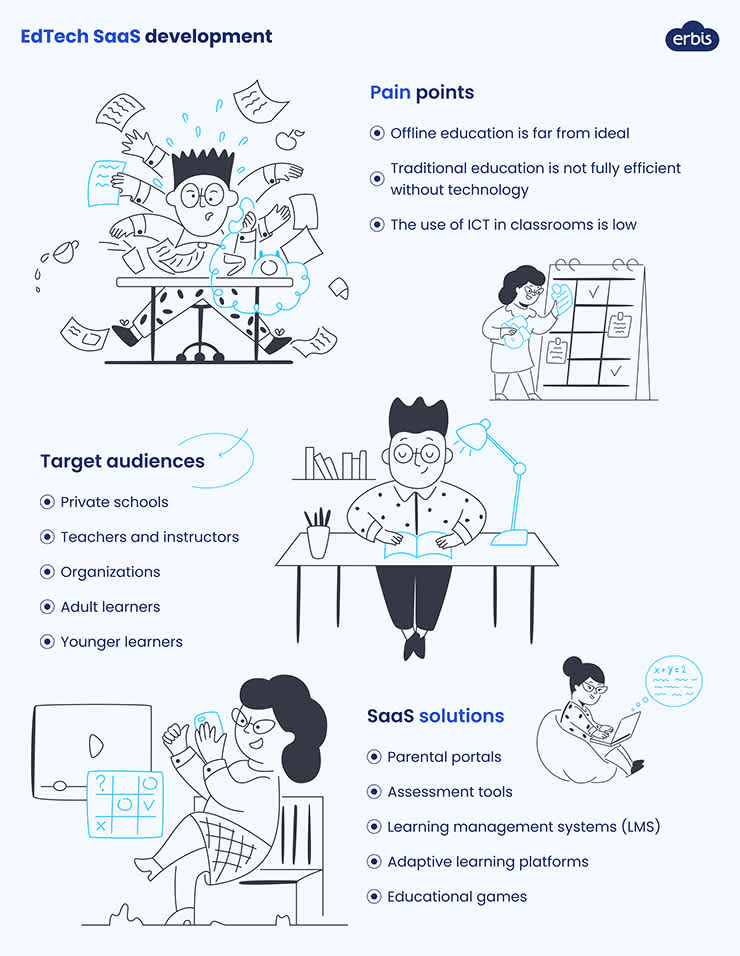
PropTech SaaS
Reasons to enter the PropTech SaaS development market
1. The number of PropTech investors is snowballing
The number of PropTech investors has more than doubled, reaching a record high of 4,693 in 2023.
Proptech Annual Barometer
2. The PropTech industry is expanding globally
The industry now covers 67 countries around the world
Proptech Annual Barometer
3. Traditional real estate companies are actively engaging in digitization
90% of companies have already secured external capital for digitization, with 38% having strategic investments for this purpose.
PropTech Ventures
4. Property buyers are increasingly relying on SaaS solutions and other property technologies
95% of property buyers use digital resources to guide them in their decision-making journey.
Glorium Tech
5. Property managers see real value in using PropTech software development solutions
65% of property managers reported that implementing digital solutions in their operations resulted in significant cost reductions.
Gitnux
Target audiences in PropTech
Construction companies. This audience often faces challenges such as project delays, cost overruns, and inefficient communication. By leveraging PropTech SaaS solutions, they can enhance communication, streamline workflows, and improve overall project efficiency.
Investors. These include real estate investors, asset managers, and financial institutions. The challenges they seek to solve with SaaS development solutions are property analytics, investment portfolio management, risk assessment, and market trend analysis.
Property managers. This includes residential, commercial, and facility property management, as well as homeowner associations. They face challenges such as extensive administrative tasks, property maintenance, and ongoing customer communication, which they aim to improve with PropTech SaaS.
Consumers. These are tenants and potential buyers. Such users are looking for convenient ways to access information, analyze available offers, and make their lives cozy in a given house or apartment.
PropTech SaaS solutions you can create
Property management software. Comprehensive platforms for managing rental properties, including features for lease management, rent collection, maintenance requests, and tenant communication.
Real estate CRM. Customer Relationship Management (CRM) systems tailored for real estate professionals to manage client interactions, leads, and sales processes.
Online property listing and search platforms. Web and mobile applications that facilitate property listing, search, and visualization, providing users with an intuitive interface to find and showcase properties.
Construction project management. SaaS solutions designed for construction and development companies to manage projects, budgets, timelines, and collaboration among project stakeholders.
Smart building solutions. IoT-enabled platforms that integrate with building systems to provide smart building solutions. These can be energy management systems, access control solutions, security systems, or home automation apps.
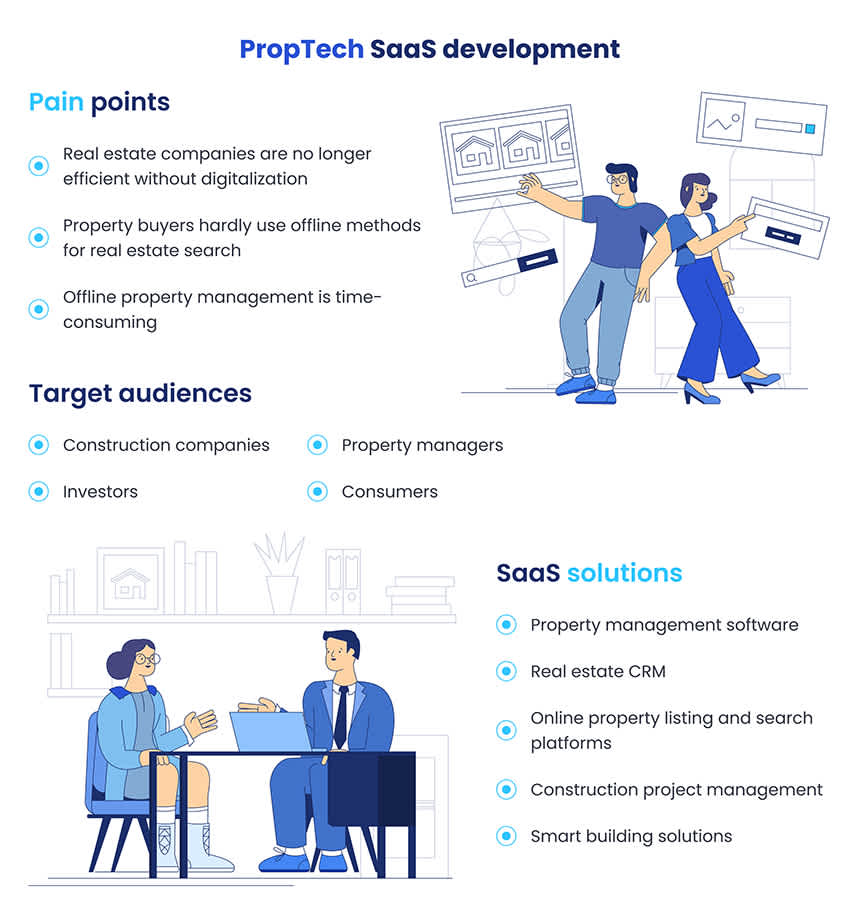
Supply chain SaaS
Reasons to enter the supply chain SaaS development market
1. Logistics companies are increasingly using SaaS and other technologies in their daily operations
In the next ten years, the majority of manufacturing enterprises will be automated by up to 80%.
DB Schenker
2. Cloud computing is now the standard platform for most supply chain software, and its adoption will continue to grow
40% is the current adoption rate of cloud computing; it is expected to reach 86% in the next five years.
2022 MHI annual industry report
3. Logistics and transportation companies believe that technology is of great help in their cost-reduction initiatives
42% of companies consider cost reduction as their leading strategy
2022 MHI annual industry report
4. Software technologies can help logistics companies identify potential disruptions, reducing the impact of unforeseen events
41% of companies say that using supply chain software has the most significant impact on managing supply chain risks
Global Supply Chain Risk Report 2023
5. Companies aim at green transformation with the help of technologies
53% of organizations plan to increase their focus on sustainability and carbon footprint reduction
DB Schenker
Target audiences in supply chain
Warehouse and distribution centers. Such companies often lack real-time awareness of warehouse operations. They expect the SaaS platform development will increase the effectiveness of inventory management and reduce overstock or stockouts.
Manufacturing companies. These potential customers have complex production planning and scheduling. They need SaaS solutions for accurate demand forecasting to establish sufficient production.
Third-party logistics (3PL) providers. The most common challenges for these companies are managing diverse service level agreements, coordinating multiple stakeholders, and providing real-time visibility to clients. Saas application development is expected to simplify operations with 3PL customers and partners.
Retailers and e-commerce businesses. These companies face fluctuating demand, seasonal variations, and order fulfillment complexities during peak periods. They seek to build SaaS applications for accurate inventory visibility across multiple channels.
Cold chain and pharma. The clients in this segment need to maintain temperature control throughout the supply chain and comply with stringent regulations for pharmaceutical transport. They are interested in logistics SaaS, helping monitor temperature and ensure the quality of products being delivered.
Supply chain SaaS solutions you can create
Warehouse management system (WMS). These SaaS solutions enhance warehouse efficiency through inventory tracking, order fulfillment, and warehouse optimization. Features may include real-time analytics, barcode scanning, and task automation.
Manufacturing execution system (MES). They help plan and schedule production. If you decide to create an MES SaaS application, consider integrating with suppliers, offering demand forecasting, and enabling real-time monitoring of the entire manufacturing process.
Logistics management platform. This SaaS custom software should offer functionalities for order processing, shipment tracking, and communication with clients and other stakeholders. Real-time visibility features can enhance transparency in logistics operations.
Retail and e-commerce management software. When engaging in e-commerce SaaS development, you should remember that customers are interested in inventory management, order processing, and demand forecasting features. You should also allow your SaaS solution to integrate with multiple sales channels, provide real-time inventory visibility, and offer tools for managing peak periods.
Cold chain monitoring system. This focuses on temperature control, compliance management, and quality assurance in pharmaceutical logistics. When building a SaaS app, include real-time temperature tracking, compliance documentation features, and alerts for potential deviations.
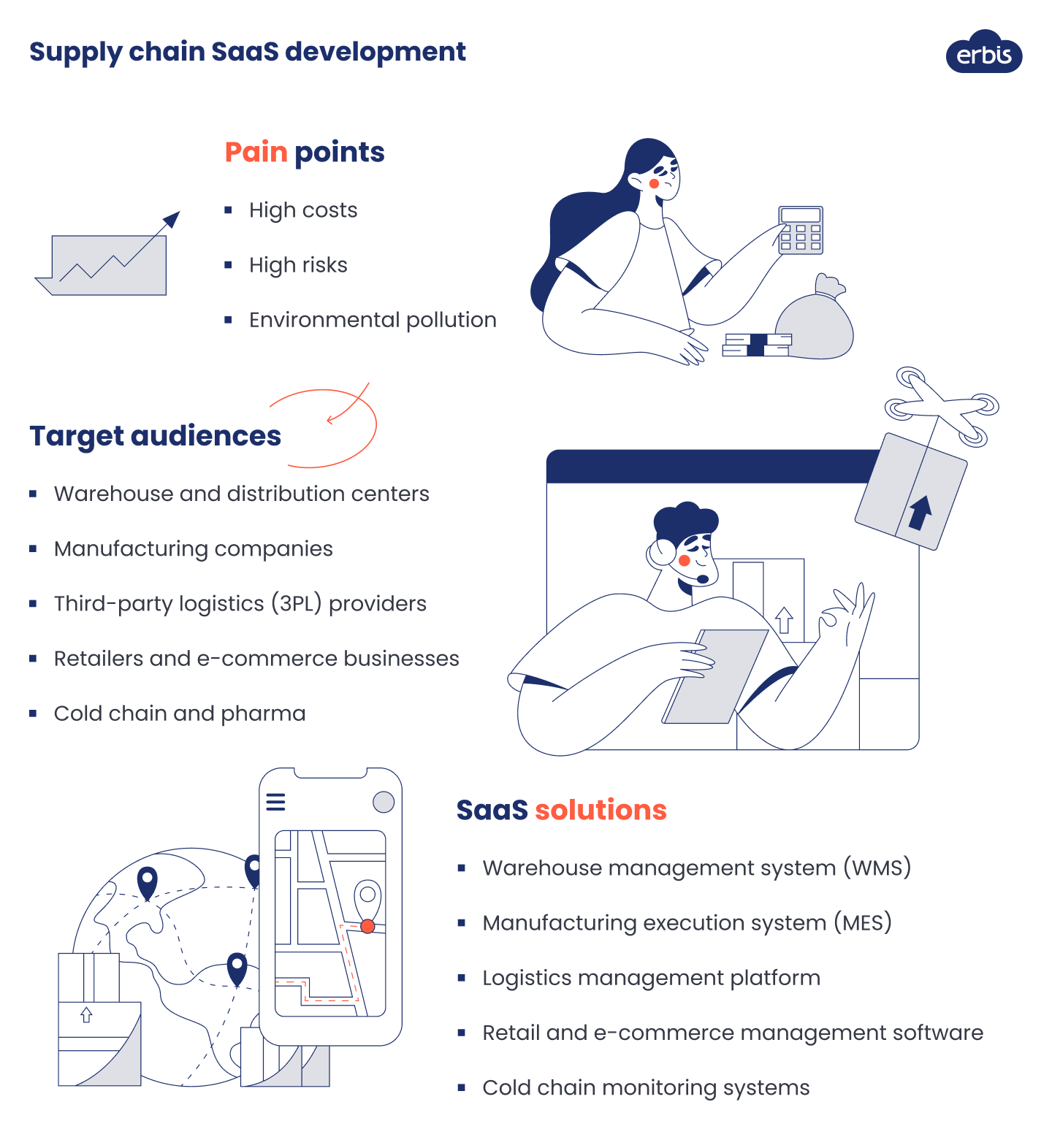
Healthcare SaaS
Reasons to enter the healthcare SaaS development market
1. Understanding the crucial importance of data, healthcare organizations are looking for efficient ways to collect and use information
38% of healthcare establishments need cloud infrastructure consultants, and 26% need big data, decision support, and analytics consultants.
Black book market research
2. Most top healthcare organizations need unified software software solutions to facilitate their daily activities
60% of respondents use over 50 different software solutions to manage healthcare operations; 88% of CIO respondents confirm that these disparate IT systems complicate their jobs.
2022 symplr Compass survey
3. Healthcare organizations have a solid intention to adopt technologies
91% of US healthcare organizations plan on implementing or have already begun technology adoption initiatives
PR Newswire
4. Healthcare institutions see benefits from SaaS development
32% of healthcare organizations cited cost savings as a significant benefit of SaaS adoption.
HIMSS Analytics
5. Healthcare professionals see SaaS solutions as a way to optimize their workflow
Administrative work takes up one-sixth of the working hours of physicians in the United States.
National Library of Medicine
Target audiences in healthcare SaaS
Medical organizations. These organizations need comprehensive solutions for managing administrative tasks and reducing the workload on personnel. They are also interested in building SaaS platforms that adhere to high-security standards and ensure data safety.
Medical professionals. These users need solutions that make their professional work easier. In particular, they are interested in high-tech SaaS platforms that help with data collection and processing, making diagnoses, and providing timely assistance to patients.
Patients. This audience needs quick and easy access to medical services. They also want to be sure that medical professionals are reachable in urgent situations.
Healthcare SaaS solutions you can create
Practice management software. This enables medical organizations to streamline administrative tasks such as organizing medical histories, diagnoses, medications, and treatment plans. Additionally, it helps to provide customer-oriented services, reduces manual errors, and optimizes the workload of administrative staff.
Electronic healthcare records (EHR). Similar to practice management software, an electronic health record (EHR) streamlines medical workflow. EHR also allows healthcare professionals to generate digital patient records, manage appointments, and track lab tests and prescriptions.
Telemedicine solutions. These SaaS applications use technology to provide remote healthcare services, allowing patients to consult with healthcare professionals through virtual visits. The basic features are video conferencing for real-time consultations, secure messaging for communication, and integration with EHR to support remote diagnosis and treatment.
Remote patient monitoring portals. These online platforms enable healthcare providers to monitor patients' health data remotely and allow proactive care. The typical features include real-time health data monitoring, secure communication channels, and alerts informing doctors about patient health status deviations.
Image and sensor data analysis platforms. Such software development solutions interpret visual and sensor-generated data for healthcare applications. They often incorporate advanced algorithms for image analysis, ML models for diagnostic support, and integration capabilities with medical devices.
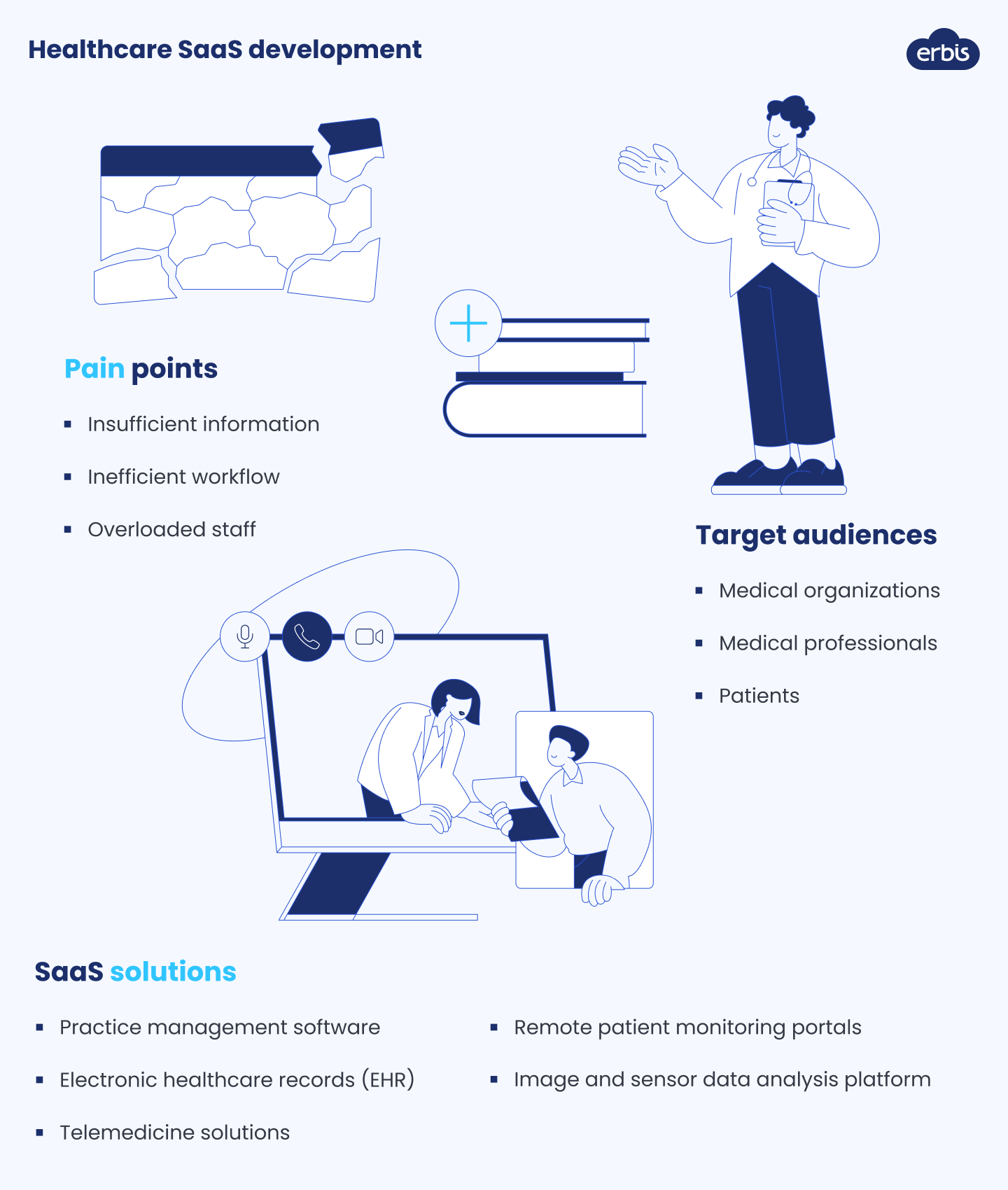
SaaS hottest trends 2024
In 2024, Software as a Service (SaaS) continues to be a powerhouse, driving digital transformations across industries. Projected to reach $282,2 bn in revenue worldwide, it will cover users across countries and continents.
AI and ML will continue to shape SaaS SW development, introducing new use cases and polishing the existing ones. However, they won't be the only SaaS trends to observe in 2024. More technologies and business directions will influence software development, which you should take into account if you want to build your own SaaS.
AI and ML in SaaS
35% of SaaS businesses are already using AI, and another 42% plan to use it in the near future.
Tech Jury
The most popular AI and ML use cases in SaaS are:
Predictive analytics. AI and ML algorithms analyze historical data to predict future trends, behaviors, and outcomes. This is particularly valuable in sales forecasting, demand planning, and risk management within SaaS applications.
Examples of SaaS solutions that provide predictive analytics are Salesforce, HubSpot, Google Analytics.
Personalized recommendations. SaaS platforms leverage machine learning to analyze user behavior and preferences, providing personalized recommendations. This is common in content platforms, e-commerce, and marketing automation systems.
Examples of SaaS development companies that use personalized recommendations are Netflix, YouTube, LinkedIn.
Natural Language Processing (NLP). NLP is used to understand and respond to human language. SaaS applications employ NLP for chatbots, virtual assistants, and sentiment analysis in customer support, making interactions more natural and efficient.
Examples of SaaS solutions that utilize NLP are Zendesk, Brandwatch, Grammarly.
Image and video recognition. AI-based image and video analysis are used in SaaS applications for content moderation, facial recognition, and object detection. This is prevalent in social media platforms, security systems, and content management solutions.
Examples of SaaS product development companies that use image and video recognition are Clarifai, VidMob, EyeEm.
Fraud detection and security. AI and ML algorithms are employed in SaaS applications to detect unusual patterns or anomalies that may indicate fraudulent activities. This is crucial in finance, e-commerce, and cybersecurity solutions.
Examples of SaaS solutions that use fraud detection and security technologies are Sift, Forter, Riskified.
Automated customer support. Chatbots and virtual assistants powered by AI are used in SaaS applications to provide instant responses to customer queries, resolve issues, and escalate complex problems to human support when necessary.
Examples of SaaS companies that provide AI-based customer support: Drift, Freshdesk (Freddy AI), Zendesk Answer Bot.
Workflow automation. ML algorithms optimize workflows by automating repetitive tasks and processes. This is valuable in project management, document processing, and collaboration tools, improving overall efficiency.
Examples of SaaS product development companies providing workflow automation: Workato, Zapier, Kissflow.
Vertical SaaS
Vertical SaaS tailors software solutions to the unique needs of specific industries. This is opposed to horizontal SaaS, which sticks to the one-size-fits-all model, where customers from multiple industries can use a given SaaS software product.
The size of the vertical SaaS market is expected to increase from $123.0 bn in 2022 to $402.4 bn by 2032. Additionally, the adoption of vertical SaaS solutions is anticipated to grow at a CAGR of 12.6% throughout the forecast period.
Future Market Insights
Vertical SaaS vs. Horizontal SaaS
Horizontal SaaS and Vertical SaaS represent two different approaches to providing software solutions. They differ based on their target audience, scope, and industry focus.
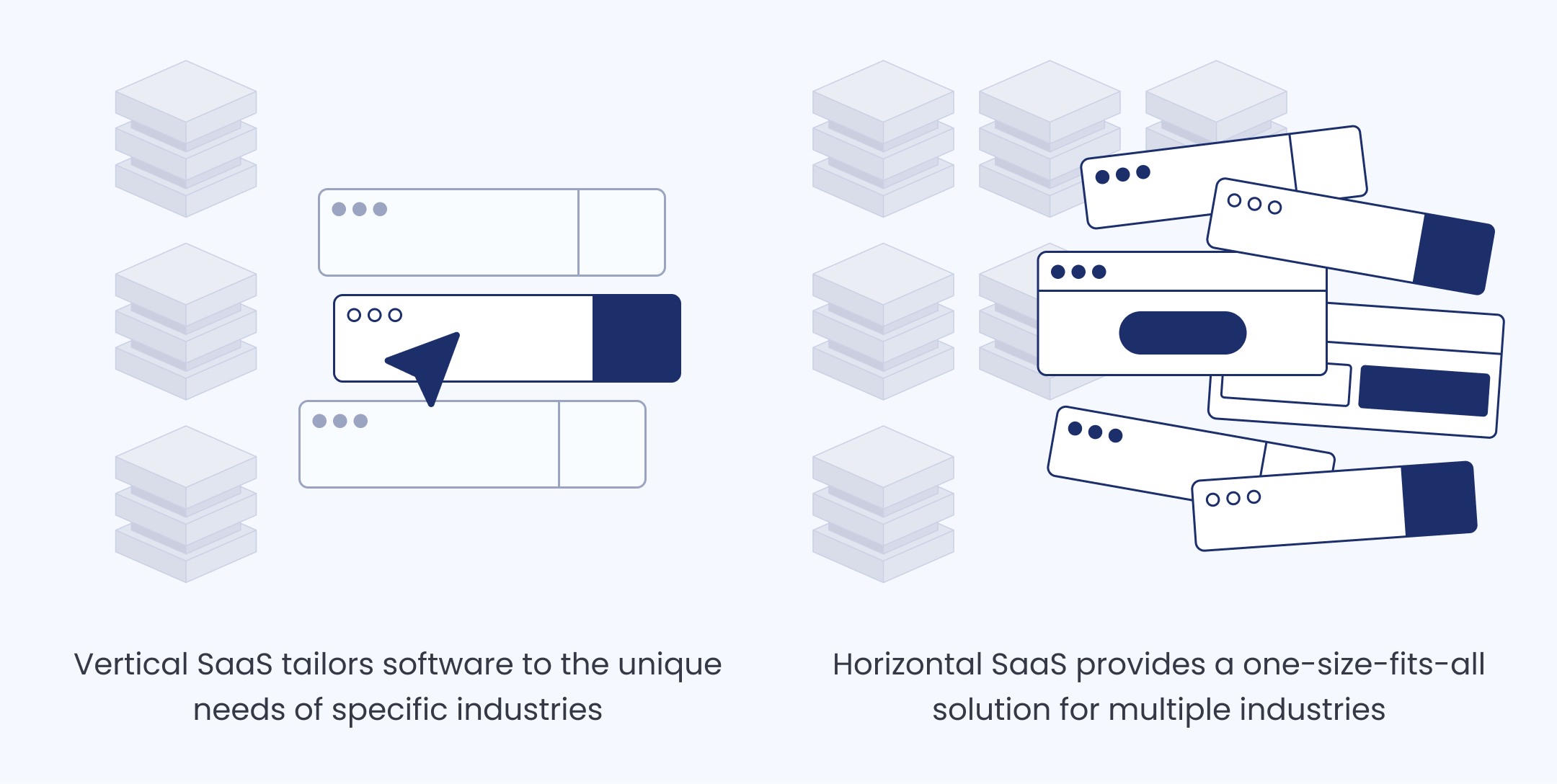
Target audience
Horizontal SaaS. Targets a broad audience and is designed to serve the needs of various industries and business functions. Horizontal SaaS solutions are general-purpose and aim to provide a wide range of features applicable across different sectors.
Vertical SaaS. Targets specific industries or verticals. It is tailored to the unique requirements of a particular sector, offering specialized functionalities relevant to that industry.
Functionality
Horizontal SaaS. Offers a comprehensive set of features that cater to general business processes such as collaboration, communication, and project management. The functionalities are broad and applicable across diverse domains.
Vertical SaaS. Provides industry-specific functionalities and tools. The scope is narrower, focusing on a specific vertical's particular needs and workflows, such as healthcare, finance, or manufacturing.
Customization
Horizontal SaaS. Tends to be more flexible and customizable to accommodate the general needs of a broad user base. Users can adapt the software to fit their requirements within the predefined framework.
Vertical SaaS. Offers a higher level of customization tailored to the specific demands of the industry it serves. The software is finely tuned to match the unique processes and regulations of the targeted vertical.
Implementation time
Horizontal SaaS. Generally has shorter implementation times due to its out-of-the-box nature and broad applicability. It may have lower complexity in terms of configuration and setup.
Vertical SaaS. May require a longer implementation time, as it involves aligning the software with the intricate processes and regulations of a specific industry. The complexity is often higher due to the need for customization.
Market size and competition
Horizontal SaaS. Targets a larger market and faces broader competition. The user base is diverse, spanning multiple industries and sectors.
Vertical SaaS. Addresses a niche market with a more focused user base. While competition may be more concentrated within the specific industry, the potential market size is limited to that particular vertical.
Vertical SaaS vs. horizontal SaaS
Horizontal SaaS | Criteria for comparison | Vertical SaaS |
Broad | Target audience | Particular sector |
Tailored to general business processes | Functionality | Industry-specific functionalities |
Shorter | Implementation time | Longer |
Lower | Complexity | Higher |
Large | Market size | Niche |
Broader | Competition | Lower |
Horizontal SaaS examples
Salesforce (customer relationship management) provides SaaS applications for sales, service, marketing, and more, catering to diverse industries.
Microsoft 365 (office productivity suite) offers productivity tools, including Word, Excel, PowerPoint, and collaboration features, serving businesses across sectors.
Slack (team collaboration) facilitates communication, file sharing, and project management, applicable to teams in different industries.
QuickBooks (accounting) offers SaaS for small businesses to handle bookkeeping, invoicing, and financial management.
Dropbox (file storage) provides file-sharing and synchronization services for users in diverse fields.
Zendesk (customer support) offers ticketing, live chat, and knowledge-based SaaS solutions that are applicable to businesses in various sectors.
HubSpot (marketing automation) provides an integrated SaaS platform for inbound marketing.
Vertical SaaS examples
Epic Systems (healthcare) provides specialized EHR solutions that streamline patient care and administrative processes.
Veeva Systems (life sciences) offers cloud-based SaaS encompassing CRM, clinical data management, and regulatory compliance.
Clio (legal practice management) sees its mission as transforming the legal experience for all and offers a handy SaaS solution for streamlining workflows for law firms and practitioners.
Buildertrend (construction) provides project management SaaS that enhances collaboration and efficiency in the construction industry.
Yardi Systems (real estate) covers all needed features for residential and commercial property management, leasing, and accounting.
Canvas LMS (education) facilitates online learning, course management, collaboration, and assessment tools.
Aptean (food and beverage) addresses the unique challenges of the industry through comprehensive SaaS solutions for supply chain management, compliance, and quality control.
Micro SaaS
Micro SaaS refers to a SaaS business targeting a niche market with a small, focused product. It typically operates with a small team (often even a single individual or a few people) and aims to solve a specific problem or cater to a particular need within a larger ecosystem. The idea is to do one thing exceptionally well for a very specific user base.
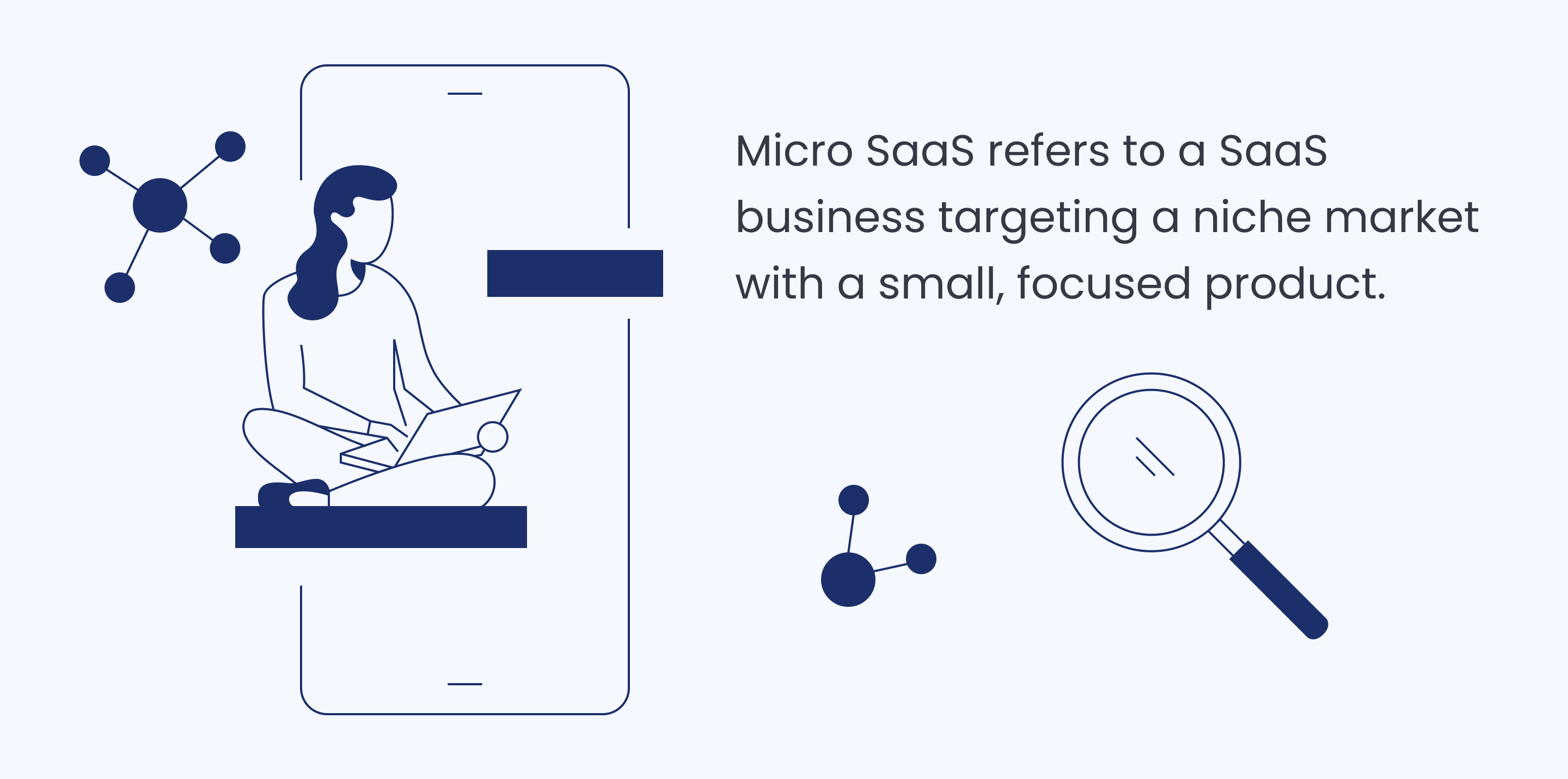
Characteristics of micro SaaS solutions
Niche focus. Targets a very specific market or user need.
Small team. Often run by an individual or a small team, keeping overhead low.
Limited feature set. Provides a focused set of features, avoiding the complexity of larger platforms.
Sustainability. Designed to be profitable with a smaller user base and typically bootstrapped.
Integration. Often integrates with larger platforms or services, adding value to an existing ecosystem.
Specific problems that micro SaaS apps solve
Micro SaaS apps excel at solving highly specific problems. Such problems are often overlooked by larger companies offering broader solutions. These are usually very particular pain points experienced by a niche market or within a larger workflow. Here are several examples of specific problems that micro SaaS products often address:
Streamlining a subset of tasks. Focusing on automating a small, repetitive part of a workflow. This can be scheduling social media posts for very small businesses or freelancers, offering a more focused solution than larger, more complex platforms.
Industry-specific needs. Addressing unique challenges faced by a specific industry. Examples are micro SaaS tools for restaurants to manage and publish their daily menus online or software for small law firms to handle case notes and billing.
Enhancing existing platforms. Creating add-ons or plugins for popular platforms. For example, a micro SaaS could provide a specialized reporting feature for Shopify that isn't offered natively or a security enhancement tool specifically for WordPress sites.
Niche market solutions. Providing SaaS solutions for niche markets or hobbies. These could be detailed tracking and analytics for drone enthusiasts or a tool designed for indie game developers to manage beta tests and collect feedback.
Localized solutions. Addressing regional problems. For example, micro SaaS might help small businesses in a specific country navigate local tax laws or provide localized weather analysis for farmers in a particular region.
Professional services automation. Micro SaaS apps often serve small agencies or freelancers. They provide highly specialized tools for client onboarding, project proposals, or invoicing, which might not be adequately covered by larger, more generic tools.
Customer relationship enhancements. Offering a specific type of CRM functionality, like managing follow-up emails or tracking customer interactions in a unique way that's not covered by broader CRM systems.
Content niche focus: Tools that help create, manage, or optimize content for very specific niches, such as a SaaS that allows real estate agents to create virtual tours or a service that converts blog posts into scripts for YouTube videos.
Accessibility solutions. Providing SaaS tools that help businesses make their websites more accessible to people with disabilities. This is a specific requirement that general web development platforms might not fully address.
Micro SaaS examples
Micro SaaS businesses are typically small and serve niche markets, so they might not be widely recognized like major SaaS development companies. However, many have gained a substantial following within their specific niches. Here are a few examples of known micro SaaS products:
Nomad List. Provides detailed information and a community for digital nomads worldwide, helping them find the best places to live and work remotely. It's a niche resource catering to a specific lifestyle.
Storemapper. It is a simple tool that allows businesses to add a store locator to their website. It's a focused solution that's particularly useful for small to medium-sized businesses with physical retail locations.
Baremetrics. This micro SaaS provides analytics and insights for businesses using Stripe, Shopify, and other payment gateways. It's designed to give smaller companies the kind of business intelligence and analytics that would typically be available to larger enterprises.
Flick. A micro SaaS tool for finding, analyzing, and managing Instagram hashtags. It caters to influencers, marketers, and small business owners looking to optimize their Instagram strategy.
Feature upvote. This SaaS tool allows companies to collect and manage customer feedback with a simple upvoting system. It's a focused solution for product managers and customer service teams looking to prioritize feature requests and improvements.
ManyPixels. ManyPixels offers unlimited graphic design services for a flat monthly fee. It's designed for startups, freelancers, and small businesses needing regular graphic design work without the overhead of hiring a full-time designer.
Indie Hackers. While it's more of a community platform, Indie Hackers qualifies as a micro SaaS by providing tools, resources, and a forum for independent entrepreneurs to share stories, advice, and strategies.
MailerLite. While now larger, MailerLite started as a micro SaaS offering intuitive tools for email marketing, catering to small businesses and creators who needed simple, effective email solutions.
White label SaaS
White-label SaaS refers to a SaaS solution developed by a third-party provider but resold by another company under its own brand. In this model, the original software is designed to be customizable and adaptable to the branding requirements of different businesses, allowing them to offer the software as if it were their proprietary solution.

Key features of white-label SaaS include:
Branding. The software can be fully branded with the reseller's logo, color scheme, and other visual elements, creating a seamless and cohesive user experience that aligns with the reseller's brand identity.
Customization. White-label SaaS solutions often provide a degree of customization, allowing the reseller to tailor certain features, functionalities, or settings to meet the specific needs of their target audience.
Reseller control. The reseller has control over how the software is marketed, sold, and supported. They can set pricing, define customer support processes, and manage the overall customer experience.
Time and cost savings. Reselling a white-label SaaS can save time and money for businesses that may not have the capacity to develop software from scratch. It allows them to enter the market quickly with a ready-made SaaS product.
Scalability. White-label SaaS solutions are often designed to scale. This accommodates the growth of the reseller's business and their customer base without requiring significant infrastructure or development efforts.
White label SaaS examples
The following SaaS solutions have gained popularity as white-label offerings due to their adaptability and customization options.
WordPress. A widely used content management system that allows users to create and manage websites. Many web hosting companies and digital agencies offer white-label versions of WordPress to clients, enabling them to customize the platform for their branding.
Zendesk. A customer support and ticketing platform that is often used as a white-label solution by companies providing customer service solutions. Businesses can rebrand Zendesk's interface to align with their corporate identity when offering customer support services.
Shopify. An e-commerce SaaS platform used under white-label scenarios by online stores. The store owners can customize the platform's appearance and features to match the brand of their clients.
LiveChat. A popular live chat platform often used as a white-label solution by businesses providing customer communication services. It allows for customization to match the branding of the reselling company.
ResellerRatings. A platform for collecting and displaying customer reviews, often serving as a white-label solution for e-commerce businesses. Companies can integrate and customize it to showcase reviews under their own branding.
Wix. A website builder that is utilized as a white-label solution by web hosting companies. It allows businesses to provide website-building services under their own brand.
Hootsuite. A social media management platform for marketing agencies. As a white-label SaaS, it can be customized to showcase the agency's branding while managing social media accounts for clients.
SaaS development: key steps
When you have decided on the target audience, market segments, and ways of generating income, it's time to move on to SaaS development. Below, we describe the stages that you will need to go through when developing SaaS.
Planning
The planning stage of custom application development involves several activities and considerations. Particularly, you and your team should:
Define SaaS project scope
Specify the features and functionalities of the SaaS application
Establish project goals and objectives
Define any limitations or constraints
Plan resources
Identify the team members and their roles
Estimate the budget and financial resources
Plan the timeline for SaaS development
Select technology stack
Select programming languages, frameworks, and databases
Consider integration with third-party tools or services
Assess scalability and performance requirements
Assess risk
Evaluate technical, financial, and operational risks
Formulate contingency plans for possible challenges
Consider legal and compliance factors
Plan user experience (UX) design:
Outline the user interface (UI) and user flow in your SaaS
Create SaaS wireframes
Consider accessibility and usability principles
Plan security
Identify potential security threats and vulnerabilities
Plan encryption methods and authentication processes
Establish protocols for data privacy and compliance
Choose SDLC model
Choose between Agile, Scrum, Waterfall, or other software development lifecycle (SDLC) frameworks
Establish communication channels and reporting mechanisms
Define milestones and deliverables
Consider legal and compliance requirements
Identify applicable laws and regulations
Draft terms of service, privacy policies, and any necessary legal documents
Plan for data protection and user rights
Develop project documentation
Create project roadmap, RACI matrix, software requirements specification (SRS), test cases and scenarios, risk mitigation, and disaster recovery plans
UI/UX design
During the UI/UX design stage, the development team focuses on creating the visual and interactive elements of the SaaS software. The UI/UX design process involves several key activities:
User research
The SaaS development team conducts user research to understand the target audience, their preferences, and behaviors. This may involve surveys, interviews, and usability testing to gather insights that inform design decisions.
Wireframing
Wireframing is creating low-fidelity sketches of the SaaS user interface. It helps visualize the layout and structure of the software without getting into detailed design elements.
Prototyping
This is where the design team builds interactive models of the SaaS software to simulate user interactions. This helps test and validate design concepts before full development begins.
Information architecture
The SaaS design and development team defines the information architecture, including the organization of content, navigation pathways, and the overall structure of the application. This ensures a logical and intuitive flow for users.
Visual design
Visual design focuses on the aesthetics of the SaaS product, including color schemes, typography, and graphic elements. The goal is to create a visually appealing and cohesive interface that aligns with the brand and user expectations.
Interaction design
Interaction design defines how users interact with the software. It includes designing buttons, menus, and other interactive components to ensure a seamless and intuitive user experience.
Responsive design:
With the prevalence of various devices and screen sizes, the UI/UX design team ensures that the SaaS is responsive. This means the interface adapts and functions well on different devices, such as desktops, tablets, and smartphones.
Accessibility
The team considers accessibility principles to ensure that the software is usable by individuals with disabilities. This may involve designing for screen readers, providing alternative text for images, and ensuring keyboard navigation.
Usability testing
Usability testing involves gathering feedback by having users interact with prototypes or early designs. This iterative process helps identify usability issues and areas for improvement.
Collaboration with the SaaS development team
Collaboration between the UI/UX designers and developers is crucial. The designers provide design specifications, assets, and guidelines to ensure the development team implements the intended user interface accurately.
Documentation
The UI/UX design team creates documentation that outlines design decisions, guidelines, and specifications. This documentation is valuable for both the development team and any future updates or iterations of the software.
Note: Even though we've mentioned the design stage before development in our publication, design doesn't strictly come before development. SaaS design and development are more like parallel processes that naturally complement each other.
Development
This is where SaaS platform development actually begins. It's impossible to cover all the nuances in this topic in this post. However, here are the key points that are essential in developing a new SaaS product or upgrading an existing one.
SaaS PoC
A Proof of Concept (PoC) in SaaS development demonstrates the feasibility and viability of a software concept.
PoC shows if a software solution can be implemented from a technical point of view.
During the Proof of Concept (PoC) phase, developers invest significant time into researching, studying technical documentation, and testing various technologies.
Typically, one or two features with the highest potential value for the SaaS product are tested. If their technical feasibility is confirmed, the team advances to the next stage of development.
Tip: During the PoC phase, it is acceptable to prioritize short-term needs over long-term goals. For instance, if investors require evidence of the feasibility of your idea, you can use readily available and familiar technologies at present and replace them with more advanced and trendy ones in the future.
SaaS MVP
Following a successful PoC, the development process transitions to the Minimum Viable Product (MVP) stage.
The MVP is a foundational version of the SaaS product that includes only the essential features necessary to address the core needs of the target audience.
During the MVP stage, the development team focuses on delivering a functional and user-friendly version of the product with a minimal set of features. This strategic approach allows for quicker time-to-market. It enables the team to gather valuable user feedback and validate the product's market fit.
Tip: Do not rush to respond to every user's feedback. Otherwise, you risk creating a SaaS product that does not meet the real needs of the target audience. Use tools such as Google Analytics, Hotjar, or Firebase to analyze user behavior. Additionally, when gathering verbal feedback, delve into the reasons behind users' requests for changes or new features. There's a significant chance that their issues could be resolved more simply.
Full-fledged SaaS
After the successful validation and refinement of the MVP, the development process advances to the full-featured SaaS product. This is when the team enhances the SaaS product with advanced features, addressing a broader range of user requirements and business needs.
Key characteristics of the full-fledged SaaS solution include
Comprehensive feature set
Scalable IT infrastructure
Optimized performance
Enhanced UI and UX
Broad customization options
Integration with third-party services
SaaS security and compliance
Note: It's important to understand that the development of a full-fledged SaaS solution is not a one-time event but rather a long-term process. This process can take anywhere from a few months to a few years to complete. During this time, the development team works continuously to improve the SaaS solution, adding new features and adapting to the changing market requirements.
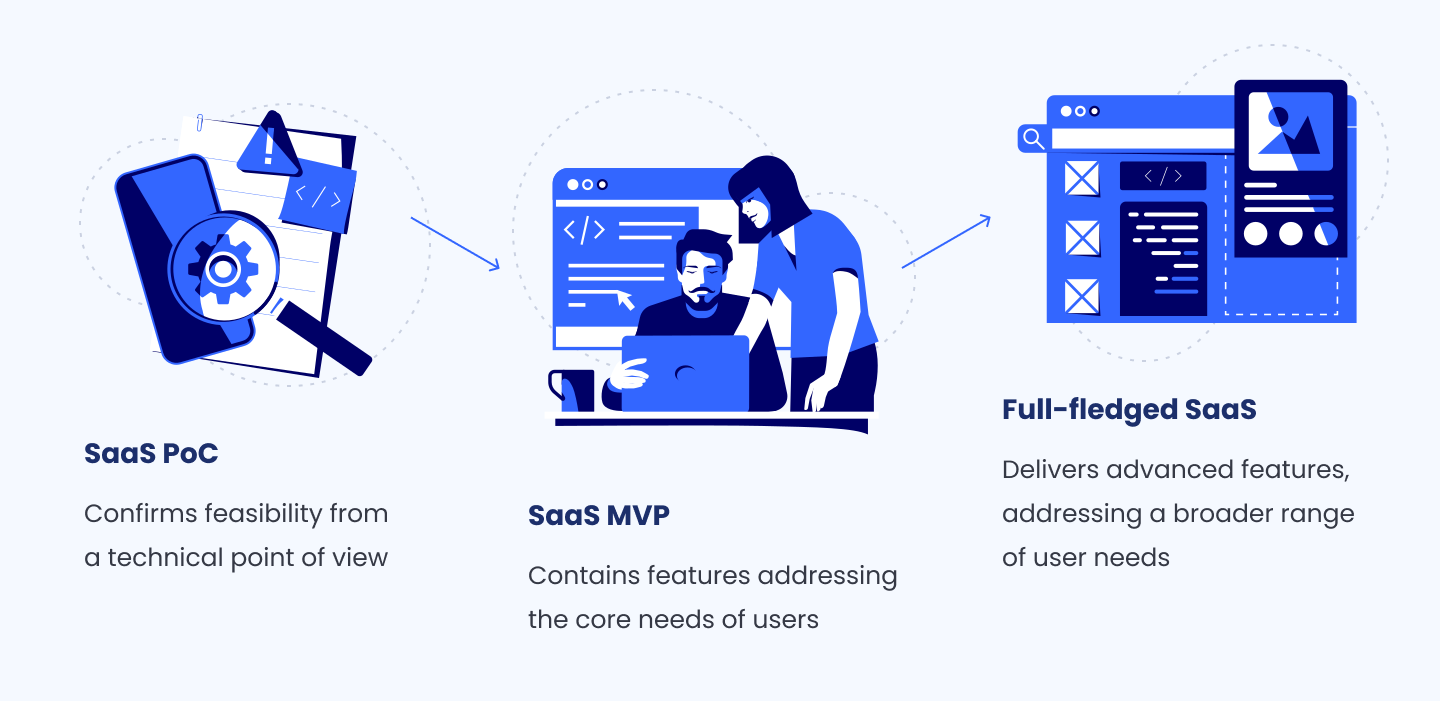
Testing
The testing stage in the SaaS app development process involves systematically evaluating the software to ensure its adherence to quality standards. Key components of the SaaS testing stage include:
Unit testing
SaaS software developers conduct unit testing to evaluate individual components of the software in isolation. It ensures that each part functions as intended and helps identify any coding errors.
Integration testing
Integration testing assesses the interactions between different components of the SaaS. It aims to detect issues arising from the integration of various elements.
System testing
System testing evaluates the entire system as a whole. It verifies that all components work together seamlessly and meet the defined requirements.
Acceptance testing
Acceptance testing confirms whether the software meets the specified acceptance criteria and is ready for deployment. It often involves collaboration with stakeholders and end-users.
Functional testing
Functional testing assesses the SaaS product's functionality against the specified requirements. It verifies that the software performs its intended tasks correctly.
Non-functional testing
Non-functional testing evaluates performance, usability, reliability, and security. Examples include load testing, usability testing, and security testing.
Regression testing
Regression testing ensures that new code changes or feature additions do not negatively impact existing functionalities. It helps maintain the overall stability of the SaaS software.
Performance testing
Performance testing assesses the SaaS' responsiveness, speed, and scalability under various conditions. This includes load testing to determine how the system performs under heavy user loads.
Security testing
Security testing identifies vulnerabilities and weaknesses in the SaaS software to protect against potential security threats. It includes penetration testing and vulnerability assessments.
Usability testing
Usability testing assesses how user-friendly the software is, focusing on the user interface, navigation, and overall user experience.
Compatibility testing
Compatibility testing ensures the software functions correctly across various devices, browsers, and operating systems.
Alpha and beta testing
Alpha and beta testing involve releasing the software to a limited audience (alpha) or a broader user group (beta) to gather feedback and identify potential issues before a full release.
Deployment
Here, SaaS developers make the software available for use by end-users. This phase includes several activities to ensure a smooth and successful launch of the SaaS application:
Infrastructure setup
The SaaS development team configures and sets up the necessary infrastructure to host and support the SaaS application. This may involve cloud services, servers, databases, and other components.
Environment configuration
SaaS developers configure the production environment to mirror the testing and development environments. They ensure the configuration settings are optimized for performance, security, and scalability.
Data migration
It may be necessary to migrate data from the development or testing databases to the production environment. This process ensures that the production environment has the latest data.
Release planning
The release manager outlines the deployment process, including specific tasks, timelines, and responsibilities. This helps coordinate efforts and ensures a systematic deployment.
Rollback planning
SaaS developers create a rollback plan in case any issues occur during deployment. A rollback plan outlines the steps to revert to the previous version or configuration if unexpected problems arise.
Monitoring setup
The SaaS development team sets up monitoring tools and systems to track the deployed SaaS application's performance, availability, and user interactions. This helps identify and address issues promptly.
Security measures
This stage includes implementing security measures to safeguard the SaaS application and its data. This may include encryption, access controls, and other security best practices.
Maintenance
The maintenance stage in the SaaS development process involves ongoing activities to support, enhance, and optimize the deployed application. Key components include:
Bug fixes
This is an essential component of the maintenance stage, where SaaS developers address and resolve software issues reported by users.
Security updates
The SaaS development team regularly updates and patches the software to address new security threats and vulnerabilities. It follows security best practices to protect user data and maintain a secure environment.
Performance optimization
This includes identifying and addressing performance bottlenecks, optimizing database queries, and improving overall system efficiency.
Scalability enhancements
As the data volumes and user traffic grow, the SaaS development team ensures that the software operates efficiently and performs as expected.
Technology stack updates
With time, market demands may change, and SaaS developers should be ready to respond to them with relevant SaaS technologies.
Feature updates and enhancements
This includes introducing new SaaS features or enhancing existing ones based on user feedback, evolving market trends, and emerging technologies.
Final word
Users love SaaS because it offers swift access to desired services without unnecessary hassle. SaaS products are making waves across various industries and sectors, catering to both broad and specialized needs.
Undoubtedly, SaaS development is a field worth exploring for tech companies seeking reliable revenue streams.
For a thriving SaaS development venture, a thorough market study, careful niche selection, and the backing of an adept software development team are crucial.
With 11 years of successful SaaS development expertise, we at Erbis craft products for both innovative startups and ambitious enterprises. Need insights from SaaS experts? Shoot us a message, and we'll come back to you with a practical proposal.
References
2022 MHI annual industry report
